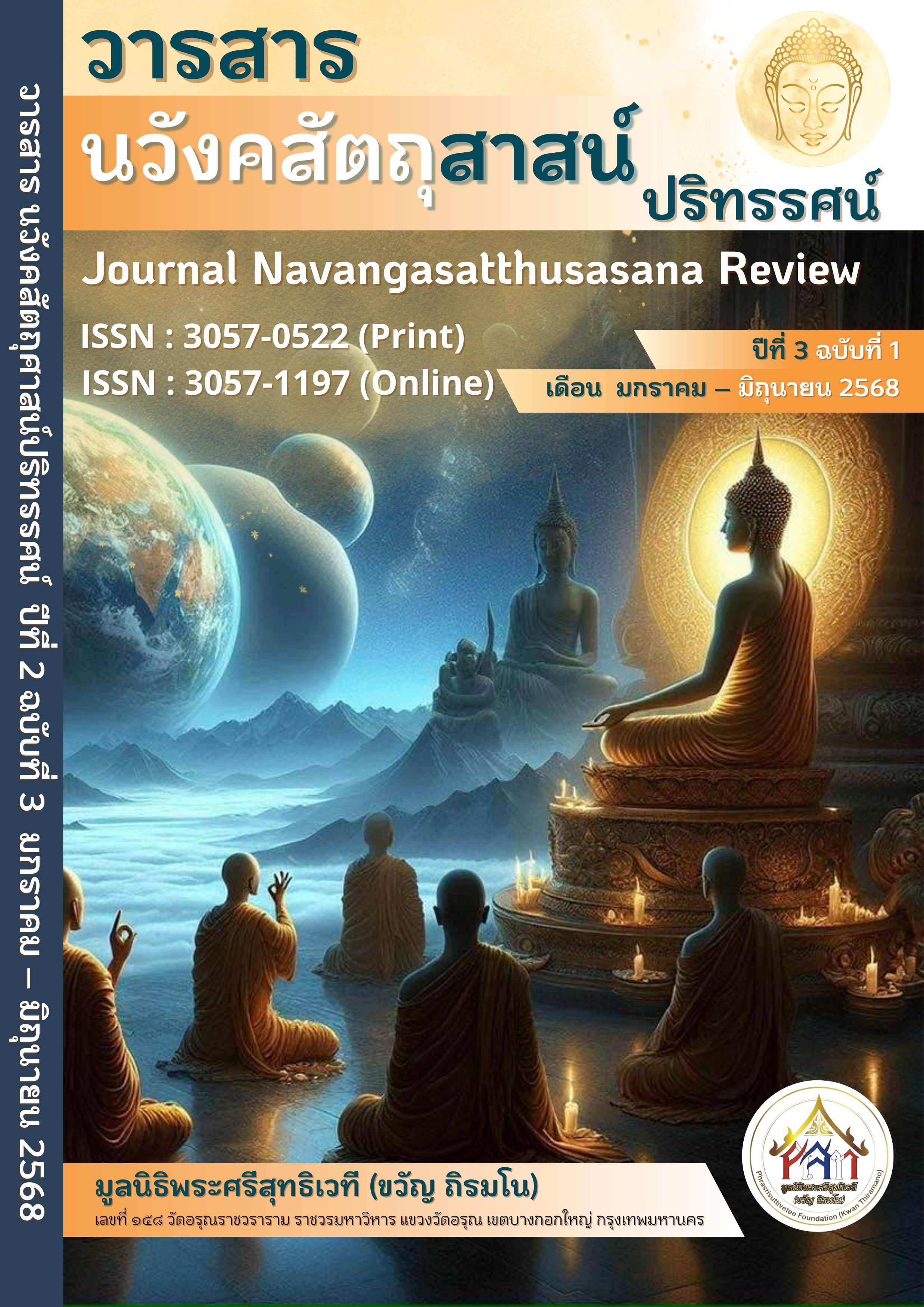Right Mindfulness in Buddhism
Main Article Content
Abstract
Right Mindfulness (Sammā Sati) in the Dhamma
describes the meaning, benefits, proper application of mindfulness according to the principles of the Buddha-Dhamma, as well as its secondary practical advantages. The inspiration for writing this book came from the intention to make it easily understandable for ordinary laypeople. The author's main objective is to emphasize the practice of mindfulness in daily life.
If we are aware and understand mindfulness correctly, we can apply it in all situations. Mindfulness can be used as a tool for present-moment awareness, not in a careless or heedless way, but as a skillful means to deal with immediate problems, or to cultivate concentration and mental power by gathering the mind and preventing distraction.
However, the true purpose, according to Buddhist principles, lies in the ultimate benefit — the eradication of defilements (kilesas) and the realization of the truth of all phenomena: that they are impermanent (anicca), unsatisfactory (dukkha), and non-self (anattā). This includes understanding the world and life as they truly are, leading to a correct attitude and perspective toward life and the world. Such insight brings about a peaceful, stable, spacious, and radiant mind — a mind that is free. It is unshaken by any worldly circumstance because it is guided by wisdom that has seen the truth. Living with such wisdom means acting in accordance with causes and conditions. This is the ultimate goal we seek, which can only be realized through practicing the Noble Eightfold Path, particularly the systematic training process known as the Threefold Training (sīla, samādhi, paññā — morality, concentration, and wisdom).
Article Details

This work is licensed under a Creative Commons Attribution-NonCommercial-NoDerivatives 4.0 International License.
เนื้อหาและข้อมูลในบทความที่ลงตีพิมพ์ในวารสาร นวังคสัตถุสาสน์ปริทรรศน์ถือเป็นข้อคิดเห็นและความรับผิดชอบของผู้เขียนบทความโดยตรงซึ่งกองบรรณาธิการวารสาร ไม่จำเป็นต้องเห็นด้วย หรือร่วมรับผิดชอบใด ๆ บทความ ข้อมูล เนื้อหา รูปภาพ ฯลฯ ที่ได้รับการตีพิมพ์ในวารสาร นวังคสัตถุสาสน์ปริทรรศน์ถือเป็นลิขสิทธิ์ของวารสาร นวังคสัตถุสาสน์ปริทรรศน์หากบุคคลหรือหน่วยงานใดต้องการนำทั้งหมดหรือส่วนหนึ่งส่วนใดไปเผยแพร่ต่อหรือเพื่อกระทำการใด ๆ จะต้องได้รับอนุญาตเป็นลายลักอักษรจากวารสาร นวังคสัตถุสาสน์ปริทรรศน์ก่อนเท่านั้น
References
พระไตรปิฎกพร้อมอรรถกถาภาษาไทย ชุด 55 ฉบับมหาวิทยาลัยมหาจุฬาลงกรณราชวิทยาลัย. กรุงเทพมหานคร: โรงพิมพ์มหาจุฬาลงกรณราชวิทยาลัย, 2553.
พระเทพเวที (ประยุทธ์ ปยุตฺโต). สัมมาสติในพุทธธรรม. พิมครั้ง 2. กรุงเทพฯ: หจก.ภาพพิมพ์, 2531.
พระพุทธโฆสเถระ. คัมภีร์วิสุทธิมรรค. แปลโดย สมเด็จพระพุฒาจารย์ (อาจ อาสภมหาเถระ). พิมพ์ครั้งที่ 10. กรุงเทพมหานคร: บริษัท ธนาเพรส จำกัด, 2554.
พระรณชัย กิตฺติราโณ (ส่งศรี). “การประยุกต์หลักใช้อริยมรรคมีองค์ 8 ในการดำเนินชีวิตของประชาชนในตำบลในเมือง อำเภอเมือง จังหวัดหนองคาย”. วิทยานิพนธ์พุทธศาสตรมหาบัณฑิต. บัณฑิตวิทยาลัย: มหาวิทยาลัยมหาจุฬาลงกรณราชวิทยาลัย, 2561.
มหาจุฬาลงกรณราชวิทยาลัย. พระไตรปิฎกภาษาไทย ฉบับมหาจุฬาลงกรณราชวิทยาลัย. กรุงเทพมหานคร: โรงพิมพ์มหาจุฬาลงกรณราชวิทยาลัย, 2539.
อาจารย์สุภีร์ ทุมทอง. อริยมรรค 8. พิมพ์ครั้งที่ 1. สมุทรปราการ: บริษัท ขุนทองอุตสาหกรรมและการพิมพ์, 2552.


